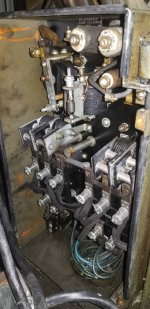OK, the actual DC control of a motor/generator (MG) machine’s spindle motor is done by the tandem pair of Ohmite rheostats. What you’re calling the “DC Controller” is properly called the DC Control Panel. It’s nothing more than a bunch of relays and a few overload devices that perform functions like: turning the spindle motor on/off; reversing the spindle motor; preventing the operator from plug reversing it; dynamic braking; and handling acceleration under load (field acceleration). But the actual speed control is done by the rheostats.
The 10EE’s MG and rheostats are part of a Ward-Leonard drive system. In a Ward-Leonard drive, the drive motor operates in two regions: base speed and field weakening. Below base speed, the drive applies full voltage to the motor’s field windings and varies the armature voltage from zero (for zero speed) to full voltage, for the motor’s “base speed”, 690 RPM for a 10EE. In the field weakening region, the armature voltage is at maximum and the field voltage it
reduced, causing the motor’s speed to
increase well above base speed; a 10EE’s spindle motor with the field fully weakened will run at 2400 RPM (without load).
The Generator Rheostat (GR) is connected as a rheostat. Its windings are connected between E1 and E2 via contacts on the F or R relay. Depending on how it's set, terminal GF2 will have a voltage that varies from 0 to 115 VDC. The GR is specially wound so that its resistance only varies for half of its range. In the upper half of the speed control’s mechanical range the GR has zero resistance between GR1 and GF1, connecting the generator’s field directly to the exciter’s 115 VDC output. Note that the GR’s windings have voltage across them any time that the F or R relay is closed; they have a resistance of about 660 Ohms and dissipate about 20 Watts (hence its large size).
The GR controls the spindle motor’s armature voltage by controlling the voltage to the generator's shunt field. If either the F (forward) or R (reverse) relay is closed (i.e., the spindle is on), the exciter will put 115 VDC across the GR. The setting of the GR determines how much voltage appears at rheostat terminal GF2 and is provided to the generator's field. Below base speed, GR varies the generator’s field voltage causing the generator’s output voltage to increase (or decrease), thereby increasing (or decreasing) the voltage that is applied to the spindle motor's armature. At speeds above the spindle motor's base speed, the GR is in the section of windings that has zero resistance and it provides full voltage to the generator's field, which causes the generator to put out maximum voltage to the spindle motor's armature.
The other Ohmite rheostat, the Motor Rheostat (MR) also varies its resistance for only half of its travel. When the speed control is in the field weakening (higher speed) range, the MR is in a section of its windings where its resistance varies. The MR is connected in series with the spindle motor's field. As you increase the speed control above base speed, the MR increases the series resistance, reducing the voltage to the spindle motor's field (weakening the field) and causing the motor's speed to increase. At maximum speed, the voltage across the spindle motor's field drops to about 40 VDC. During the entire time that the MR's resistance is increasing, the GR is in the zero resistance section. Similarly (in the base speed region), when the GR’s resistance is changing, the MR is in a zero resistance region, applying full field to the spindle motor.
The MR is always connected in series with the exciter and the spindle motor’s field, even when the spindle is off. When the spindle is off, the DC control panel connects the braking resistors across the armature. If you then try to move the spindle, the spindle motor acts like a generator and can be very difficult to turn if in back gear, since rotating the spindle causes the motor to generate voltage that is fed to the braking resistors.
I hope the above helps you understand what’s going on.
As far as checking out the MG and spindle motor without the DC control panel, it’s actually relatively simple; you just need to make a few connections between the terminal panel on the MG, the Ohmite rheotats and the spindle motor. First, rig up a switch and fuse to connect the GR to MG and control the generator’s field; you need a 1 Amp fuse wired in series with the switch.
Connect the GR to the MG, as follows:
- GR terminal E2 to MG terminal E2
- GR terminal GR1 to switch and 1 Amp fuse, then to MG terminal E1
- GR terminal GF2 to MG terminal GF2
Connect the MR to the MG and spindle motor’s field, as follows:
- MR terminal E1-2 to MG terminal E1 via a 2 Amp fuse
- MR terminal F2 to spindle motor terminal F2
- Spindle motor terminal F1 to MG terminal E2
Connect the MG to the spindle motor’s armature, as follows:
- Spindle motor terminal A1 to MG terminal GS1 via a 15 Amp fuse
- Spindle motor terminal A2 to MG terminal GA2
The fuses are in case you hook something up wrong. Obviously, all this wiring is done with the machine powered off and disconnected from power.
With the MG running and the speed control set to minimum (counter clockwise), close the switch. The spindle motor should run slowly. Adjusting the speed control clockwise should take the spindle motor from minimum speed to maximum, through both the base and field weakening regions of operation.
Cal
10EE smoking and arcing (practicalmachinist.com)








